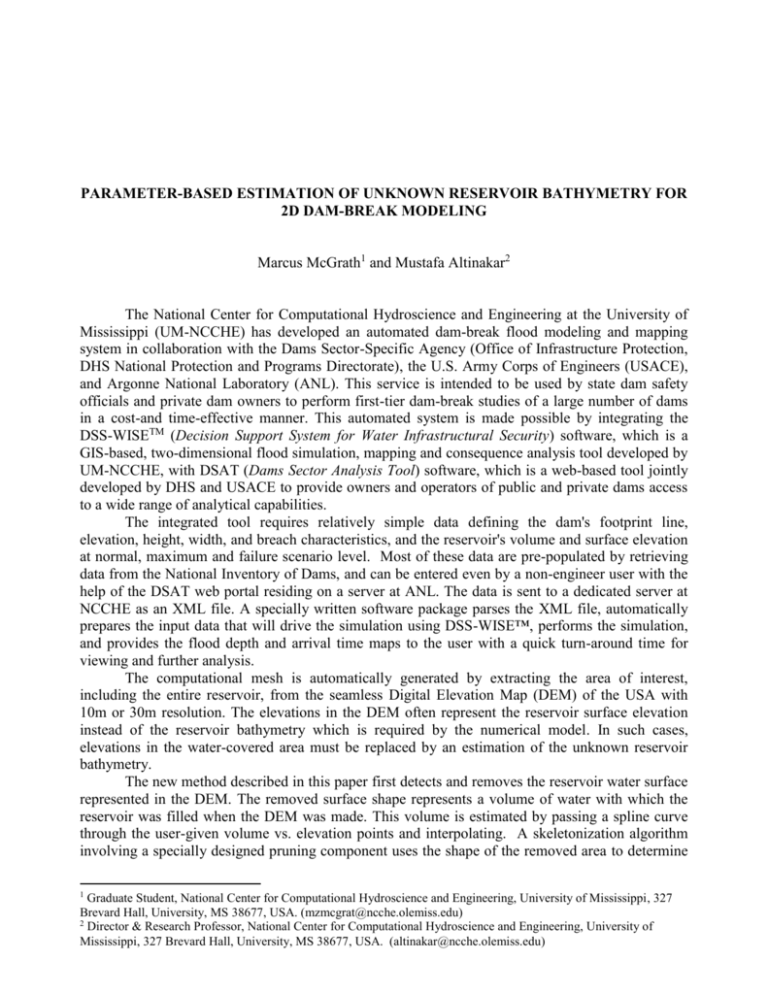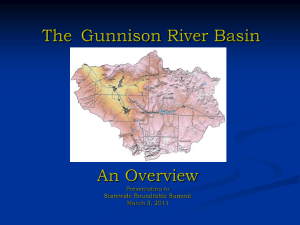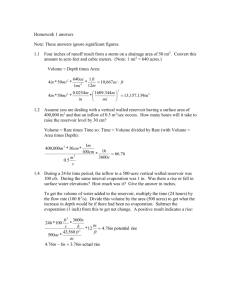PARAMETER-BASED ESTIMATION OF UNKNOWN RESERVOIR
advertisement

PARAMETER-BASED ESTIMATION OF UNKNOWN RESERVOIR BATHYMETRY FOR 2D DAM-BREAK MODELING Marcus McGrath1 and Mustafa Altinakar2 The National Center for Computational Hydroscience and Engineering at the University of Mississippi (UM-NCCHE) has developed an automated dam-break flood modeling and mapping system in collaboration with the Dams Sector-Specific Agency (Office of Infrastructure Protection, DHS National Protection and Programs Directorate), the U.S. Army Corps of Engineers (USACE), and Argonne National Laboratory (ANL). This service is intended to be used by state dam safety officials and private dam owners to perform first-tier dam-break studies of a large number of dams in a cost-and time-effective manner. This automated system is made possible by integrating the DSS-WISETM (Decision Support System for Water Infrastructural Security) software, which is a GIS-based, two-dimensional flood simulation, mapping and consequence analysis tool developed by UM-NCCHE, with DSAT (Dams Sector Analysis Tool) software, which is a web-based tool jointly developed by DHS and USACE to provide owners and operators of public and private dams access to a wide range of analytical capabilities. The integrated tool requires relatively simple data defining the dam's footprint line, elevation, height, width, and breach characteristics, and the reservoir's volume and surface elevation at normal, maximum and failure scenario level. Most of these data are pre-populated by retrieving data from the National Inventory of Dams, and can be entered even by a non-engineer user with the help of the DSAT web portal residing on a server at ANL. The data is sent to a dedicated server at NCCHE as an XML file. A specially written software package parses the XML file, automatically prepares the input data that will drive the simulation using DSS-WISE™, performs the simulation, and provides the flood depth and arrival time maps to the user with a quick turn-around time for viewing and further analysis. The computational mesh is automatically generated by extracting the area of interest, including the entire reservoir, from the seamless Digital Elevation Map (DEM) of the USA with 10m or 30m resolution. The elevations in the DEM often represent the reservoir surface elevation instead of the reservoir bathymetry which is required by the numerical model. In such cases, elevations in the water-covered area must be replaced by an estimation of the unknown reservoir bathymetry. The new method described in this paper first detects and removes the reservoir water surface represented in the DEM. The removed surface shape represents a volume of water with which the reservoir was filled when the DEM was made. This volume is estimated by passing a spline curve through the user-given volume vs. elevation points and interpolating. A skeletonization algorithm involving a specially designed pruning component uses the shape of the removed area to determine 1 Graduate Student, National Center for Computational Hydroscience and Engineering, University of Mississippi, 327 Brevard Hall, University, MS 38677, USA. (mzmcgrat@ncche.olemiss.edu) 2 Director & Research Professor, National Center for Computational Hydroscience and Engineering, University of Mississippi, 327 Brevard Hall, University, MS 38677, USA. (altinakar@ncche.olemiss.edu) the centerline of the reservoir and its major branches while avoiding spurious details. The initial and final skeleton for an example reservoir is shown at the top of Fig. 1. The DEM cells through which the centerline skeleton passes are assumed to form the thalweg elevations of the valleys within the reservoir. These thalweg lines extend from the toes of the dams with corresponding toe elevations and terminate at the shorelines at the extremities of the reservoir where the elevation is that of the reservoir surface. The elevations of other cells in the reservoir are estimated by calculating the relative distance to the skeletonized centerline and the nearest shoreline. These values, along with the value of elevation at the nearest centerline point, are used to calculate an elevation according to an interpolation function, whose parameters are optimized to provide a match between the resulting calculated reservoir volume and the estimated volume. Once calculated, the resulting bathymetry elevations replace the original water surface elevations in the DEM. An example or reservoir surface and estimated bathymetry is shown at the bottom of Fig. 1. The final step involves detecting and removing the cells under the dam so they do not interfere with its digital representation in the numerical flood model. The profile of the dam is projected onto the DEM using a user-supplied polyline, and each cell within one-half of the dam's width is removed. The elevations of these removed cells are estimated by interpolating using the values in the cells surrounding the dam, ensuring a smooth transition between the estimated reservoir bathymetry upstream and the known downstream elevations. The right side of Fig. 1 shows curves for a sample reservoir's estimated and known volume vs. water surface elevation, displaying good agreement between the two. In summary, UM-NCCHE has coupled an existing 2D numerical flood model with an automated data preparation tool which utilizes a new method for estimating unknown reservoir bathymetry. The input data is fed to this system using a web portal developed by ANL and USACE requiring a minimal amount of data and expertise by the user. Despite this minimal data input, the volume in the estimated reservoir bathymetry agrees well with known values. This paper describes the method, presents examples, and discusses the accuracy and limitations of the method. Figure 1 Top left: Initial Skeleton. Top center: Pruned skeleton. Bottom left: DEM with initial water surface. Bottom center: DEM with estimated bathymetry. Right: Example volume vs. water surface elevation plot.







